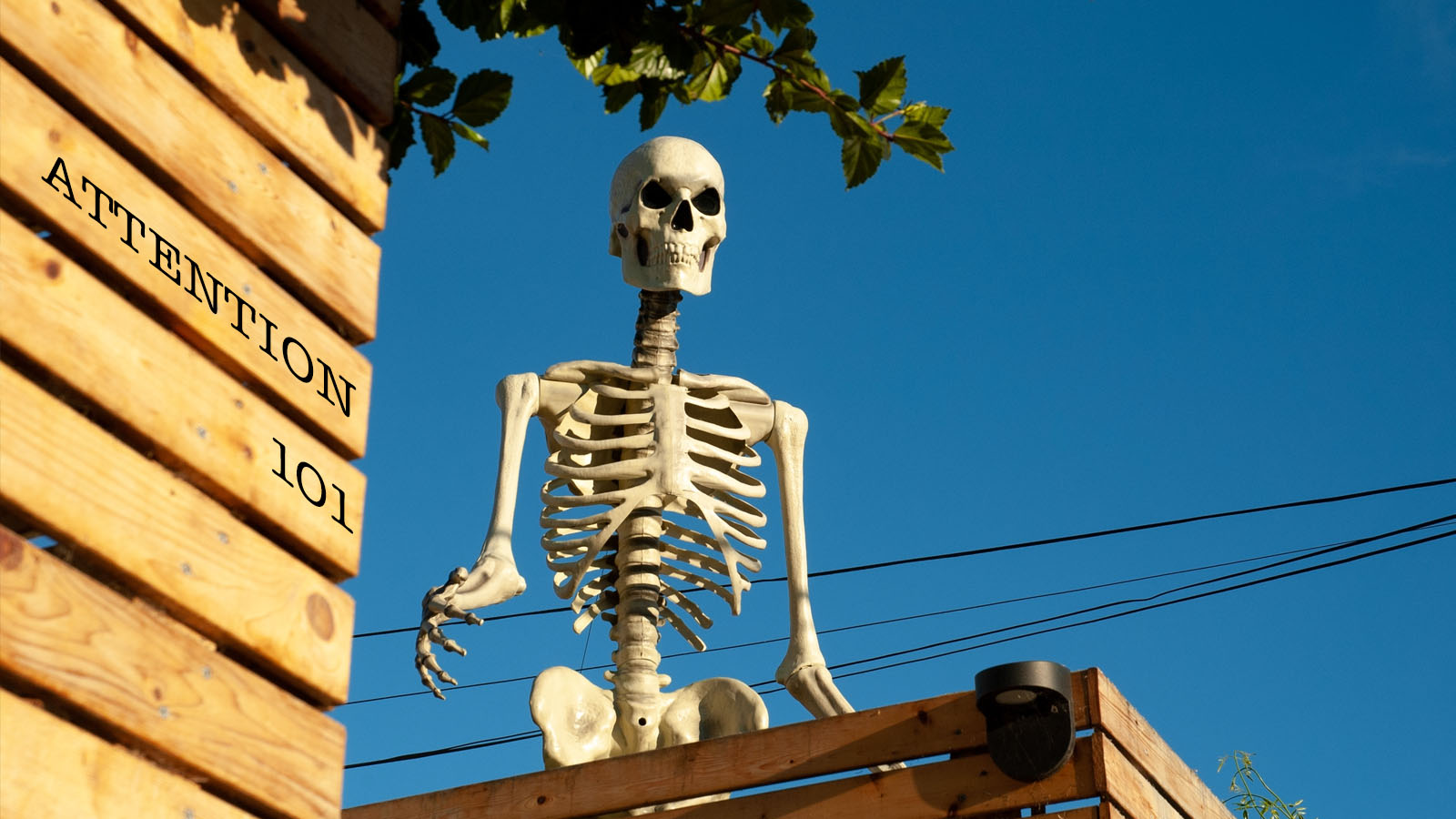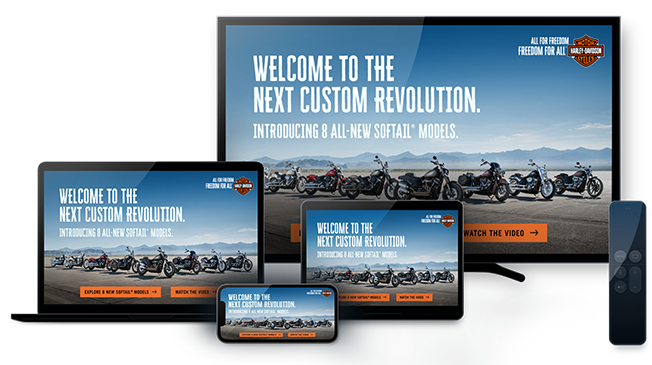Lessons in Attention from Home Depot’s Giant Skeleton

In 2020, in the middle of the strictest COVID-19 lockdowns, Home Depot unveiled a particularly unusual new product: a Halloween lawn ornament in the form of a 12-foot-tall skeleton with glowing eyes. While the product had been in development since pre-COVID, its irreverence and absurdity made it a runaway hit in an otherwise serious and stressful year. Three years later, the product fans have nicknamed “Skelly” continues to sell out.
Since its debut, “Skelly” – and Home Depot’s broader portfolio of outlandish Halloween decorations – have fascinated the marketing world. What does a brand best known for a practical selection of home and garden fixtures gain by selling a skeleton so enormous that it can peek into second-story windows?
The answer: The giant skeleton gets the right kind of hard-to-capture attention, and Home Depot backs that attention up with a savvy strategy to keep it while respecting consumers’ time. And marketers can learn from this success, whether it’s “spooky season” or not. Here are a few of the key lessons.
Don’t exploit consumers’ attention with overexposure.
One key tactic that Home Depot has maintained for the four years since it debuted the 12-foot-tall skeleton is that it doesn’t manufacture – or sell – very many of them. The company has intentionally kept quantities limited, even when it likely knows it could sell far more. As a result, “Skelly” still sells out in minutes whenever its inventory is refreshed, including when it’s nowhere near October, and even with buyers’ purchases limited to just one skeleton.
There’s an important lesson here when it comes to human attention. Imagine if, when you drove to work in the month of October, every third house on the drive had a 12-foot-tall skeleton on its lawn. You’d probably find that irritating, and likely quite disruptive to your attention. It might even give you a negative brand perception of the company responsible for selling so many skeletons. Instead, with “Skelly” sales kept scarce, seeing one in a neighbor’s lawn or along your work commute is a fun, attention-grabbing novelty.
Along the same lines, seeing an ad too many times can make consumers less likely to purchase the item. Attention is the core of marketing, but marketers need to make sure they don’t exploit it once they have it.
Know when and how to stay current.
Many people, including many advertising professionals, are surprised to hear that Home Depot has never put any paid advertising spend behind its Halloween decorations. Instead, the company works with Trade School, a digital agency based in its hometown of Atlanta, to create content for platforms like Instagram and TikTok that can be ultra-relevant at any time of the year. In July, for example, the company tapped into the fan and brand mania surrounding the Barbie movie by putting one of its skeletons into Barbie’s iconic packaging.
This kind of flexible creative strategy allows Home Depot to easily adapt “Skelly” messaging to tap into current trends and social media conversations in a way that’s able to be far more relevant than traditional paid planning would allow. It’s also helped Home Depot cement the skeleton as a year-round cult favorite at the company rather than a seasonal decoration.
But paid media can now take advantage of this, too. New ad formats, next-generation targeting, AI-driven real-time campaign insights, and dynamic creative can bring digital advertising into the realm of up-to-the-minute relevance. That way, brands can ensure they aren’t just part of a conversation, but part of the right conversation. (Don’t believe us? Drop us a line at Infillion.)
Know how to turn attention into a purchase – even if it’s not a direct one.
The 12-foot-tall skeleton is great at turning heads, but not only is it kept in intentionally scarce quantities, it’s also expensive – priced at $300, and even more on the secondary market. Plus, you need somewhere to put it, which rules out most apartment dwellers. In other words, there are a lot of people who might love to have an enormous skeleton to display every Halloween, but they aren’t customers for one reason or another. For this reason, Home Depot carefully positions “Skelly” as part of a broader curation of Halloween decor, much of which is far less pricey. This year, its “Boo on a Budget” rundown offers ideas for how to create a whole spooky porch display using Home Depot products for under $100.
The lesson for marketers here is that when you capture someone’s attention (and the skeleton certainly does), not everyone whose attention gets grabbed is going to instantly become a buyer. For advertisers, offering interactive creative with product explorations can give them a look at a brand’s products beyond the most eye-catching “shiny objects.”
Creating brand advocates is the most powerful form of marketing.
With no paid advertising spend, Home Depot lets “Skelly” speak for itself – or rather, it lets Skelly’s fans do the talking. When it comes to a brand’s back-end strategy, attention to detail and relevance is key – but when it comes to what consumers see directly from a brand, often less is more.
The skeleton’s runaway success has led to a cult following of skeleton fans; there’s even a sizable cadre of giant skeleton owners who keep them up year-round, often dressing them up in costumes for Thanksgiving, Valentine’s Day, the Super Bowl, and more. But Home Depot’s never released any accessories for “Skelly,” instead letting fans take the lead and show off their creativity. Hearing from a brand is one thing; hearing from that brand’s fans is another. Infillion’s recent research about the changing customer journey, in which shopping is an always-on state for today’s consumers, underscores this. Buying a product is no longer the end of the customer journey; becoming an advocate for it and influencing others takes that journey one step further.
The bonus: The zany subculture around “Skelly” gets consumers more invested in the Home Depot brand and makes them feel like they can be a part of it. Whether that translates to more kitchen backsplash, vinyl flooring, and weed whacker purchases during the rest of the year remains to be seen – but it certainly can’t hurt.
Spooky season may end in November, but Infillion’s takes on what’s new and what’s next in marketing are year-round. Follow us on LinkedIn for the latest.
Subscribe to our blog:
Related Posts:

How Digital Out-Of-Home Is Turning Up The Volume At Music Festivals
If you have attended a music festival sometime in the past 20 years, you’ve probably wasted at least 5 minutes holding your phone above your head, trying to get even the slightest bit of signal with little success. The sheer number of electronic devices in the area...

Smarter Targeting, Greater Value: Advancing Efficiency with Segment Optimization
In an era in which every impression is scrutinized and every dollar demands accountability, precision isn’t optional – it’s essential. That’s why at Infillion we are continually evolving the MediaMath platform to support what matters most to advertisers: Maximizing...

From Automation to Autonomy: How Agentic AI Is Rewriting the Rules of Adtech
What if your media platform could not only follow instructions, but actually understand intent, reason through nuance, and take autonomous action – all without sacrificing brand safety or human oversight? That’s not science fiction, it’s agentic AI – and it’s here to...
Let's Connect
We can help you create the personalized ad experiences viewers expect.

